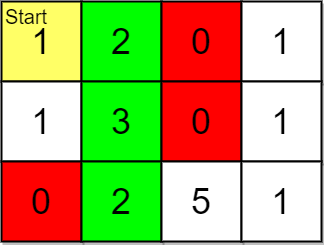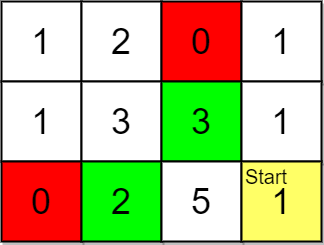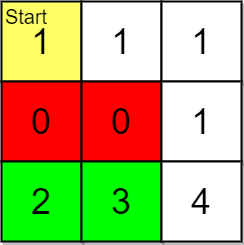- {x}
- Divide a String Into Groups of Size k
- Minimum Moves to Reach Target Score
- Solving Questions With Brainpower
- Maximum Running Time of N Computers
- The Number of Passengers in Each Bus I
- Choose Numbers From Two Arrays in Range
- Minimum Cost of Buying Candies With Discount
- Count the Hidden Sequences
- K Highest Ranked Items Within a Price Range
- Number of Ways to Divide a Long Corridor
- Count Elements With Strictly Smaller and Greater Elements
- Rearrange Array Elements by Sign
- Find All Lonely Numbers in the Array
- Maximum Good People Based on Statements
- Minimum Number of Lines to Cover Points
- The Number of Passengers in Each Bus II
- Keep Multiplying Found Values by Two
- Read More...

K Highest Ranked Items Within a Price Range
You are given a 0-indexed 2D integer array grid of size m x n that represents a map of the items in a shop. The integers in the grid represent the following:
0represents a wall that you cannot pass through.1represents an empty cell that you can freely move to and from.- All other positive integers represent the price of an item in that cell. You may also freely move to and from these item cells.
It takes 1 step to travel between adjacent grid cells.
You are also given integer arrays pricing and start where pricing = [low, high] and start = [row, col] indicates that you start at the position (row, col) and are interested only in items with a price in the range of [low, high] (inclusive). You are further given an integer k.
You are interested in the positions of the k highest-ranked items whose prices are within the given price range. The rank is determined by the first of these criteria that is different:
- Distance, defined as the length of the shortest path from the
start(shorter distance has a higher rank). - Price (lower price has a higher rank, but it must be in the price range).
- The row number (smaller row number has a higher rank).
- The column number (smaller column number has a higher rank).
Return the k highest-ranked items within the price range sorted by their rank (highest to lowest). If there are fewer than k reachable items within the price range, return all of them.
Example 1:

Input: grid = [[1,2,0,1],[1,3,0,1],[0,2,5,1]], pricing = [2,5], start = [0,0], k = 3 Output: [[0,1],[1,1],[2,1]] Explanation: You start at (0,0). With a price range of [2,5], we can take items from (0,1), (1,1), (2,1) and (2,2). The ranks of these items are: - (0,1) with distance 1 - (1,1) with distance 2 - (2,1) with distance 3 - (2,2) with distance 4 Thus, the 3 highest ranked items in the price range are (0,1), (1,1), and (2,1).
Example 2:

Input: grid = [[1,2,0,1],[1,3,3,1],[0,2,5,1]], pricing = [2,3], start = [2,3], k = 2 Output: [[2,1],[1,2]] Explanation: You start at (2,3). With a price range of [2,3], we can take items from (0,1), (1,1), (1,2) and (2,1). The ranks of these items are: - (2,1) with distance 2, price 2 - (1,2) with distance 2, price 3 - (1,1) with distance 3 - (0,1) with distance 4 Thus, the 2 highest ranked items in the price range are (2,1) and (1,2).
Example 3:

Input: grid = [[1,1,1],[0,0,1],[2,3,4]], pricing = [2,3], start = [0,0], k = 3 Output: [[2,1],[2,0]] Explanation: You start at (0,0). With a price range of [2,3], we can take items from (2,0) and (2,1). The ranks of these items are: - (2,1) with distance 5 - (2,0) with distance 6 Thus, the 2 highest ranked items in the price range are (2,1) and (2,0). Note that k = 3 but there are only 2 reachable items within the price range.
Constraints:
m == grid.lengthn == grid[i].length1 <= m, n <= 1051 <= m * n <= 1050 <= grid[i][j] <= 105pricing.length == 22 <= low <= high <= 105start.length == 20 <= row <= m - 10 <= col <= n - 1grid[row][col] > 01 <= k <= m * n
Solution Explanation:
This problem requires finding the k highest-ranked items within a given price range in a grid, considering distance, price, row, and column as ranking criteria. The solution uses a Breadth-First Search (BFS) algorithm coupled with sorting to efficiently achieve this.
Approach:
-
BFS for Traversal: A BFS algorithm systematically explores the grid starting from the given
startposition. It keeps track of the distance from thestartposition for each reachable cell. -
Price Range Filtering: During the BFS, only cells containing items within the specified price range (
pricing[0]topricing[1]) are considered. -
Storing Ranked Items: For each item within the price range, its distance, price, row, and column are stored in a data structure (like a list of tuples or a custom class in object-oriented languages). This data structure maintains the rank information of each item.
-
Sorting: After the BFS is complete, the stored item data is sorted based on the ranking criteria (distance, then price, then row, then column).
-
Returning Top k Items: Finally, the top
kitems from the sorted list are returned as a list of coordinates.
Time Complexity Analysis:
- BFS: The BFS traversal visits each cell in the grid at most once. Therefore, the time complexity of the BFS part is O(m*n), where 'm' and 'n' are the dimensions of the grid.
- Sorting: Sorting the list of items takes O((mn) * log(mn)) in the worst case (if nearly all cells contain items within the price range). This dominates the time complexity.
Space Complexity Analysis:
- Queue (BFS): In the worst case, the BFS queue can hold all cells in the grid, resulting in O(m*n) space complexity.
- Sorted List: The list storing item data can also hold up to all cells in the grid, leading to O(m*n) space complexity.
Therefore, the overall time complexity is O((mn) * log(mn)), and the space complexity is O(m*n).
Code Implementation (Python3):
from collections import deque
from itertools import pairwise
class Solution:
def highestRankedKItems(
self, grid: List[List[int]], pricing: List[int], start: List[int], k: int
) -> List[List[int]]:
m, n = len(grid), len(grid[0])
row, col = start
low, high = pricing
q = deque([(row, col, 0)]) # (row, col, distance)
visited = set()
visited.add((row, col))
pq = [] # list to store (distance, price, row, col)
while q:
r, c, dist = q.popleft()
price = grid[r][c]
if low <= price <= high:
pq.append((dist, price, r, c))
for dr, dc in [(0, 1), (0, -1), (1, 0), (-1, 0)]:
nr, nc = r + dr, c + dc
if 0 <= nr < m and 0 <= nc < n and grid[nr][nc] > 0 and (nr, nc) not in visited:
q.append((nr, nc, dist + 1))
visited.add((nr, nc))
pq.sort() #sort by distance, price, row, col
result = []
for i in range(min(k, len(pq))):
result.append([pq[i][2], pq[i][3]])
return result
Other Languages: The solution can be implemented similarly in Java, C++, Go, TypeScript, and other languages using their respective data structures and sorting functions. The core algorithm remains the same. The provided solution in the question already contains implementations in Java, C++, Go, and TypeScript.